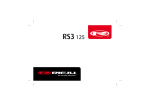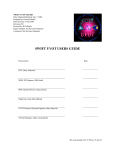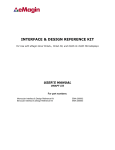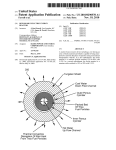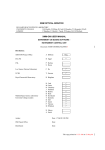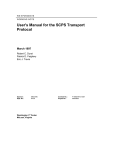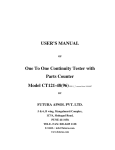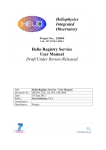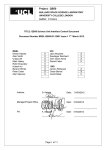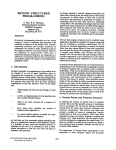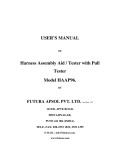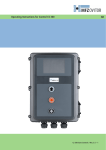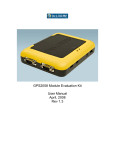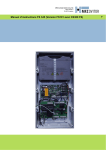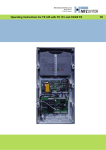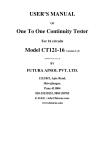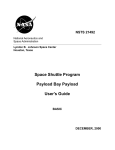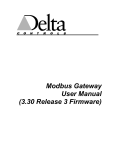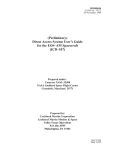Download Penn. State J. Nousek P. R - Mullard Space Science Laboratory
Transcript
SWIFT-UVOT MULLARD SPACE SCIENCE LABORATORY UNIVERSITY COLLEGE LONDON H. E. Huckle, P.J.Smith SWIFT-UVOT ICU FLIGHT SOFTWARE TEST REPORT Document: MSSL/SWT-UVOT/MSSL/TR/009.1 Distribution: Penn. State J. Nousek P. Roming P. Broos S. Koch P. Altimore GSFC D. Bundas R. Borelli Mullard Space Science Laboratory R. Card M. Carter M. Cropper B. Hancock M. Hailey H. Huckle H. Kawakami K. Mason P. Smith A. Smith P. Thomas J. Tandy SWIFT-UVOT Project Office T. Kennedy Orig Author: Date: Authorised By: Date: Distributed: Date: Table of Contents 1 OVERVIEW ................................................................................................... 3 2 DEFINITIONS, ACRONYMS AND ABBREVIATIONS.................................. 3 3 TEST ENVIRONMENT .................................................................................. 4 4 PROBLEMS DETECTED AND CORRECTED.............................................. 5 5 NON CONFORMANCE REPORTS (NCRS) ................................................. 9 6 VERIFICATION MATRIX............................................................................. 10 1 Overview This document summarizes the UVOT-ICU Flight Software testing that took place between Sep 2002 and December 2002 at MSSL. This is due for delivery at end January 2003 and will be labeled as ‘release 3’. Full details of individual tests can be found in ‘Swift-UVOT ICU Code Build 5 Test Plan’ delivered as part of the Acceptance Data Package for the UVOT. 2 Definitions, Acronyms and Abbreviations 1553 ACK APID AT BPE CVS DCI DCS DEM DPU FoM FoV FSW F/W HK HV ICB ICU LED NAK PT QM RTS SAA S/C I/F SSI STOL S/W TBC TBD TC TDRSS TM TM TMPSU UVOT MIL-STD 1553B Interface Acknowledgement Application Identifier Automated Target Blue Processing Electronics Concurrent Versions System Data Capture Interface – BPE - DPU interface along which detector events are sent. Deferred Command Store Digital Electronics Module Data Processing Unit Figure of Merit Processor Field of View Flight Software Filter Wheel House Keeping High Voltage Instrument Control Bus Instrument Control Unit Light Emitting Diode No AcKnowledgement Planned Target Qualification Model Relative Time Sequence South Atlantic Anomaly Spacecraft Interface Serial Synchronous Interface Spacecraft Test and Operations Language Software To Be Confirmed To Be Defined TeleCommands Tracking and Data Relay Satellite System TeleMetry Telescope Module Telescope Module Power Supply Unit Ultra Violet Optical Telescope 3 Test Environment TELESCOPE SIMULATOR (Linux) DPU SIMULATOR (Dos) ICB SSI Tartan ADA (Solaris) ICU P I C RS 232 DEBUG PC (Linux) 1553 S/C SIMULATOR Ethernet 10BaseT Code Repository Code Version Control Documentation (Solaris) ITOS (Linux) The ICU used is the qualification model (QM) ICU. The DPU simulator is a PC containing an SSI interface card. The operating system is DOS. A C-based program monitors the SSI interface and responds to any DPU commands sent down the SSI from the ICU with the anticipated response. A debug PC, interfaced to the ICU via a PIC based interface, is used for rapid code load direct into memory and to monitor debug locations. The spacecraft is simulated via a SwRI supplied Spacecraft Simulator. The UVOT telescope module is emulated on code running on a Linux based PC containing a Macsbus interface. The C-based code is adapted from that developed for the XMM-OM instrument. ITOS is run on a Linux based PC to control the test, display HK and maintain logs. All code is maintained in a CVS controlled repository on a Solaris based Sun. 4 Problems Detected and Corrected In the event of an ‘RTS Call Stack exceeded ‘ error it was still possible to exit from safe state without performing a reboot (and thus risking not forcing a reload of important tables). This was corrected. The utility dcsgen that generates the on-board summary of the command database was found to be making the table too large. Routine load_tables.c was changed (new CVS rev 1.25), the table regenerated and reloaded and the ICU rebooted to check for now bad CRC messages. Incorrect indication of ‘aliveness’ of the filter wheel control task was corrected. Occasional failure to move the filter wheel to the requested position (one in several hundred) was observed. This is only seen when using a non-nominal filter wheel movement command (when asking the filter wheel to move to a filter by counting the number of fine sensor pulses). This has been declared as an NCR. Additional incorrect error message was received when attempting to command the ICB directly without sending the correct enabling command previously. Corrected and fixed. The code crashed during the combination of a value out of limits requiring an RT2RT command to be sent at the same time as the spacecraft interface was disconnected (to simulate a problem with the spacecraft). Code corrected and retested successfully. Environmental tests at GSFC reported an interaction with the filter wheel commanding and the ihtrparams command that resulted in heater control becoming disabled. A test was devised which replicated the problem. The code was then modified and tested successfully. The BPE safety circuit was seen to give an alert on first command. However, it was realized that the test did not follow the correct STOL proc of first loading a Centroid table. When this STOL proc was performed, no alert was given. Therefore no code change was performed. As a result of experience gained during the environmental tests at GSFC, it was decided to modify HV RTSs so as to change limits ' on -the-fly' to reflect the changing limit ranges in the various states. Visual inspection of code in limit.adb revealed that the STOL proc used to change several limits ' on -the-fly' would not work correctly. The code was therefore modified to fix it. All tests involving HV ramping were subsequently monitored for correct operation of limits changes and successfully passed. Whilst testing the previous problem by modifying the hv.rts and state_changes.rts STOL procs to use the facility, it was noticed that the new HV limit values (read in directly from EEPROM) were incorrect. This was tracked down to a compiler bug which resulted in the incorrect calculation of the EEPROM address containing the new limit. The code was modified and retested by running an AT exposure (which includes ramping up and down HVs) whilst checking, using debug statements, that the correct HV limit values were being used. Note - during this investigation a bug was found in the disassembler part of the dcsgen utility that generates the RTS table uploads (corrected, retested and checked in as CVS revision 1.24 of memory.c). This only impacts the printed output of this utility. It was noticed during exposure testing that some exposures were prematurely terminated whilst entering/exiting the SAA. This was caused by incorrect calculation of total exposure times at that source. This was tracked down to a failure of the 'perform_slew' RTS to interrupt a prior exposure until after it had changed the state flag, thus signalling an incorrect status to the exposure time calculation in the Ada code. The fault was rectified in state_changes.rts (CVS rev 1.11). Visual inspection of table description file state_table.def indicated that the transitions to states to all the 'off' states did not use the non-RTS revs of the safing commands. This was corrected and reloaded. The fault was rectified in state_table.def (CVS rev 1.9) BUT NOT TESTED. When returning to an AT exposure that had been interrupted by a PT exposure, the code did not recognize that an XRT position had been received previously. This caused it to select the wrong exposure configuration from the table of AT exposure configurations. The code was corrected (uvotman.adb CVS rev 1.50) and retested successfully. It was reported from GSFC environmental testing that commands which requested that the focussing heaters be always off sometimes resulted in the heaters being briefly on. Investigation of the problem also revealed the possibility of heaters being briefly off whilst being commanded to be always on. A test was devised which recreated the problem. The heater algorithm code was modified and successfully passed the test. It was noticed that the ICU incorrectly reported a ‘UVOT Mode Exhausted’ when attempting to restart a constraint interrupted chart exposure. This was traced to a variable initialisation problem. The test was successfully rerun. In addition, a simple AT exposure test was rerun successfully to ensure the code modification had no unforeseen side effects. It was also noticed in the previous test that moving the filter wheel under RTS control during an exposure could lead to the heater control, which is temporarily disabled during these moves to limit the current used, would occasionally fail to restart. This was corrected by modifying the code so that internal requests from the filter wheel control algorithm to stop and start the heater control are held off until the previous heater start or stop is completed. The test was rerun and successfully completed. It was noticed that that the detector threshold was incorrectly set to zero when running an AT exposure. uvotman.adb was modified to ensure that the standard value is always loaded from the EEPROM table. The HK display then correctly displayed the value. Whilst running STOL proc 'atmoon', an Ada exception occurred. It was traced to a compiler optimisation bug when filling out the catalogue_star packet, associated with negative declinations. Code in uvotman.adb wasatered to avoid the problem and test rerun to confirm it was fixed. Tagged in CVS as test_plan_mod13 Whilst running STOL proc 'atstar' after 'springcanopus', it was noticed that it was incorrectly allowing the exposure to take place. This was traced to a failure to save a flag in CHECK_CATALOG_SOURCES in uvotman.adb. The problem was fixed and retested successfully. It was CVS installed as test_plan_mod14. It was noticed when forcing a constraint error by changing the ra and dec that the appropriate safing action did not take place whilst changing state from safe to idle. This was because the state flag (which is polled to determine whether there is any point in running a safing action) is not reset until at least SAA HV voltages are set. The solution was to check that both state and next_state flags are both set to safe before deciding that the safing action should be suppressed. The test was rerun and successfully passed. The code was CVS tagged as test_plan_mod15. Visual inspection of STOL proc file state_changes.rts indicated that the gotosafe RTS did not disable the events from the detector. In addition, the interrupt_exp RTS did not, as a backup to the Ada code, perform a failsafe setting of the flood LEDs to zero. The relevant changes were made and checked in as CVS rev 1.16. A PT exposure was performed using STOL proc shortpt.proc which was then interrupted by running an AT exposure using STOL proc shortat.proc, which was in turn interrupted by sending a 'gotosafe' command. No unexpected behaviour was observed. It had been noticed, whilst running test 14.11, that when going back to the AT for a second time (i.e. when the NEW_AT flag was not set) that the slew_to_settling RTS ran briefly and then correctly switched to slew_to_finding. Although the exposures taken were correct (i.e. it did not attempt to perform a settling exposure) this behaviour was an unnecessary overhead. The problem was eventually traced to an incorrect entry in the state_table.def file. The entry was corrected and the test rerun. This time the slew_to_finding STOL proc ran immediately on going back to an AT the 2nd time. Whilst disconnecting and reconnecting the stoi simulator for >= 45 seconds (in order to simulate a spacecraft malfunctions), it was found that the watchdog tripped. Investigation appeared to show that it was related to an excess of messages as the ICU attempted to keep running a recovery RTS that was already running. The incidence of watchdog trips was considerably reduced (although not completely eliminated) by adding code to uvotman.adb that suppressed attempts to run a recovery RTS if it was already running. The code was CVS tagged as test_plan_mod16. As this has not been completely eliminated, this problem has been declared and NCR – see below. Whilst running test 17.15 (settling on wrong target) it was noticed that the message 'Not at Predicted Position' did not appear. This was traced to a failure to set the FONEXTOBSINFO_RECEIVED flag in uvotman.adb. This was corrected and the test rerun correctly. CVS tagged as test_plan_mod17. Visual inspection of dpu.adb indicated that the ‘Unexpected ACK/NAK’ message was incorrectly commented out. Reinserted in dpu.adb and shortat STOL proc rerun to check that nothing unexpected happened. During testing at GSFC it was noticed that the hour angle has 180 subtracted from it instead of 12. Rev 1.15 of astro.adb was edited to fix this problem to produce rev 1.16. This makes no difference mathematically as the result is brought into the range 0-24 afterwards. The code was retested during hot-bench testing. During hot-bench testing at GSFC in December 2002, it was noticed that the calculated positions of astronomical bodies were incorrect. This was caused by the spacecraft clock epoch being 2001 when the code in time.adb was expecting 1968. Rev 1.22 of time.adb was edited to correct this problem to produce rev 1.33. The code was retested during Hot-Bench testing. 5 Non Conformance Reports (NCRs) As a result of both the above testing and environmental tests at GSFC, the following NCRs are declared. 5.1 MSSL NCR 26 Visual inspection of the uvotman.adb package time-since-burst time calculation incorrectly uses an MJD rather than a spacecraft time subtraction. - requires a 2 word array subtract of time from time.getmet() rather than the current incorrect MJD subtraction. 5.2 MSSL NCR 27 ACS NHK swamping occurs when the spacecraft dies and stopping telemetry polling can make the ICU watchdog trip.- requires a flag set to be used to disable ACS missing NHK when sending TM is impossible 5.3 MSSL NCR 28 Filter wheel fails to find the correct position when the hkrate = 4, but only when stepping the filter wheel in the contingency mode of n fine sensor pulses.- happened once but not yet reproduced 5.4 MSSL NCR 29 It is not possible to perform a settling exposure.The HV ramping time required (~16 seconds) for Vcathode is longer than the maximum possible length of the settling phase (~ 12 seconds). It was only possible to perform such an exposure during testing by using an unrealistically long settling time. - Modify Ada code and settling exposure RTS so as to commence exposure before HVs or spacecraft have settled 5.5 MSSL NCR 30 High voltage creeping problem - the MCP23 voltage creeps up with continuous cathode ramping 6 Verification Matrix NB: Unless otherwise stated, tests numbered are those in the Build 5 (Final) Test. FWST refers to the Filter Wheel Special Test. HVST refers to the High Voltages Special Test. The requirement numbers are from the ICU software requirements document. Requirement General 3.1.1 3.1.2 Interface Support Relevant test(s) Status By design, this is so. 6.2 Verified Verified 3.2.1 6.2, 6.3, 6.4, and any AT exposure e.g. 14.2 5.1, 9.2, 10.2, 10.2, 14.5, all of the FWST, all of the HVST Verified 3.2.2 3.2.3 5.2, 8.5, 14.2 Autonomous Control of Instrument 3.3.1 3.3.2 3.3.3 3.3.4 3.3.5 3.3.6 3.3.7 3.3.8 3.3.9 3.3.10 SUPERCEDED 3.3.11 SUPERCEDED 3.3.12 SUPERCEDED 3.3.13 SUPERCEDED 3.3.14 SUPERCEDED 3.3.15 REMOVED 3.3.16 3.3.17 3.3.18 21.1 By design, this is so, e.g. see 11.1 14.2, 14.3, 14.4, 14.5, 14.6, 14.7, 17.17 14.2 14.2 11.1 11.1 11.1 11.1 1) 14.12 2) 14.8 3) 16.10 1) 16.10 2) 16.12 3) 16.12 16.12 16.10 16.10 11.1 By design, this is so, e.g. see 11.1 14.2 14.2 Verified for ICB for non HV on h/w, on simulator for HV and with release 2 with flight TM in calibrations at GSFC. Verified Verified Verified Verified Verified Verified Verified Verified Verified Verified SUPERCEDED SUPERCEDED SUPERCEDED SUPERCEDED SUPERCEDED REMOVED Verified Verified but see NCR 29. Verified Requirement 3.3.19 3.3.20 3.3.21 3.3.22 3.3.23 3.3.24 Relevant test(s) 14.11 14.2 14.3 14.2 16.10 part 2 14.4 14.4 3.3.25 3.3.26 3.3.27 3.3.28 Preparation for Slew 16.12 14.2 14.4 14.5 14.8 Status Verified Verified Verified Not Done Verified Verified for UVOTMODES > 0x1000 Verified Verified Not verified. Verified 3.4.1.1 14.8 Bright Source Avoidance - Stars Verified 3.4.2.1.1 Verified By design, this is so (see UVOT ICU user manual) 3.4.2.1.2 By design, this is so (see UVOT ICU user manual) 3.4.2.1.3 14.2 3.4.2.1.4 15.6 Bright Source Avoidance - Planets 3.4.2.2.1 15.4 3.4.2.2.2 15.4 3.4.2.2.3 REMOVED Bright Source Avoidance – Sun, Earth and Moon 3.4.2.3.1 15.1, 15.3 3.4.2.3.2 15.2 Bright Source Avoidance – General 3.4.2.4.1 15.1, 15.2, 15.3, 15.4, 15.5 Detector Safing Circuit 3.4.3.1 FWST 1.17 3.4.3.2 FWST 1.17 3.4.3.3 FWST 1.17 3.4.3.4 FWST 1.17 3.4.3.5 FWST 1.17 3.4.3.6 FWST 1.17 3.4.3.7 FWST 1.17 South Atlantic Anomaly 3.4.4.1 REMOVED 3.4.4.2 All of section 16 3.4.4.3 All of section 16 Out-of-Limit Conditions 3.4.5.1 17.5, 17.6, 17.7, 17.8, FWST 1.17 Verified Verified Verified Verified Verified REMOVED Verified Verified Verified Verified Verified Verified Verified Verified Verified Verified REMOVED Verified Verified Verified except for DPU values (simulation inadequate at time of test). Requirement Relevant test(s) 3.4.5.2 3.4.5.3 3.4.5.4 3.4.5.5 3.4.5.6 3.4.5.7 3.4.5.8 Spacecraft Attitude 3.4.6.1 By design 17.5, 17.6, 17.7, 17.8, FWST 1.17 REMOVED 17.5 with alternate table 17.5 17.5 17.5 17.1 3.4.6.2 17.14 3.4.6.3 17.14 Safehold 3.4.7.1 14.13 DPU Control and Monitoring 3.5.1 6.2, 6.3 3.5.2 6.5 3.5.3 6.5 3.5.4 14.2 3.5.5 6.4 3.5.6 6.3 ICB Ports 3.6.1.1 9.3 3.6.1.2 9.3 Detector Digital Electronics 3.6.2.1 8.3 3.6.2.2 8.3 3.6.2.3 8.3 3.6.2.4 9.2 3.6.2.5 9.2 3.6.2.6 9.2 3.6.2.7 9.2 3.6.2.8 9.2 3.6.2.9 FWST 1.16 Detector Analogue Electronics 3.6.3.1 HVST 2, HVST 3, HVST 4, HVST 5, HVST 6, 14.2 3.6.3.2 HVST 1, 14.4 Mechanisms – General 3.6.4.1.1 FWST 1.15 Mechanisms – Filter Wheel Status values (simulation inadequate at time of test). Verified Verified REMOVED Verified. Verified Verified Verified Occasionally fails – see PR17 Verified Verified Not verified. Verified Verified Verified Verified Verified Verified Verified Verified Verified at unit level test. Verified at unit level test. Verified at unit level test. Verified Verified Verified Verified Verified Verified at unit test level. Verified on simulator and during environmental testing with release 2 at GSFC. Verified on simulator. Verified at unit test level Requirement 3.6.4.2.1 Relevant test(s) FWST 1.9, FWST 1.10 3.6.4.2.2 3.6.4.2.3 3.6.4.2.4 3.6.4.2.5 3.6.4.2.6 3.6.4.2.7 3.6.4.2.8 Mechanisms – Dichroic 3.6.5.3.1 FWST 1.11 FWST 1.2 FWST 1.3 FWST 1.4 FWST 1.5 FWST 1.6 FWST 1.7 3.6.5.3.2 FWST 1.13 3.6.5.3.3 Thermal Control 3.6.6.1 3.6.6.2 3.6.6.3 3.6.6.4 3.6.6.5 3.6.6.6 Watchdog 3.7.1 3.7.2 3.7.3 Housekeeping Control 3.8.1 3.8.2 State Transitions 3.9.1 Memory Maintenance 3.10.1 3.10.2 3.10.3 Telemetry Control 3.11.1 3.11.2 Timing REMOVED Verified on release 2 at GSFC in environmental testing. Verified on release 2 at GSFC in environmental testing. REMOVED 10.1 10.2 10.2 10.2 10.1 Extra Heater Test 2 Verified Verified Verified Verified Verified Verified 9.6 9.6 8.1 Verified Verified Verified 5.4 5.3 Verified Verified 18.1 Verified 4.1 4.1 4.1 Verified on release 2. Verified on release 2. Verified on release 2. REMOVED REMOVED REMOVED REMOVED FWST 1.13, FWST 1.14 Status Verified on simulator, unable to validate directly on h/w. However, indirectly verified by correct functioning of filter wheel. Verified Verified Verified Verified Verified Verified Verified Requirement Relevant test(s) 3.12.1 2.1 Telecommands – general 3.13.1.1 3.1 3.13.1.2 14.2 3.13.1.3 8.4, 9.7 3.13.1.4 By design, this is so, e.g. see 8.4, 9.7 3.13.1.5 9.7 Telemetry – General 3.14.1.1 By design, this is so – the timestamp is reliant on the accuracy of the electronics. 3.14.1.2 6.5 3.14.1.3 By design, this is so. 3.14.1.4 By design, this is so. Telemetry – Housekeeping 3.14.2.1 5.1, 5.3, 8.4, 9.3, 9.5, 9.7, 10.2, 11.1, 13.1, 14.2, HVST 1, HVST 2, FWST 1.4, FWST 1.7, FWST 1.9, FWST 1.10, FWST 1.13, FWST 1.15, FWST 1.17 3.14.2.2 By design, this is so. 3.14.2.3 5.1 Telemetry – Log Packets 3.14.3.1 1) 8.4, 9.7 2) All of sections 2, 3, 4, 5, 6, 8, 10, 11, 12, 13, 14, 15, 16, 17, 18, 19, 20, all of the FWST, all of the HVST 3) as for 2) above. 3.14.3.2 1) 8.4, 9.7 2) All of sections 2, 3, 4, 5, 6, 8, 10, 11, 12, 13, 14, 15, 16, 17, 18, 19, 20, all of the FWST, all of the HVST 3) as for 2) above. Memory Dumps 3.14.4.1 REMOVED Telemetry Management 3.14.5.1 REMOVED Status Verified Verified Verified Verified. Verified Verified Verified Verified Verified Verified Verified except that HV values monitored on simulator. Verified Verified 1) Verified 2) Verified 3) Verified 1) Verified 2) Verified 3) Verified REMOVED REMOVED














